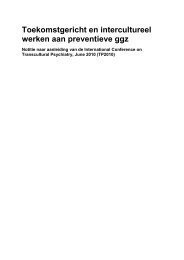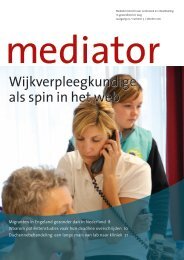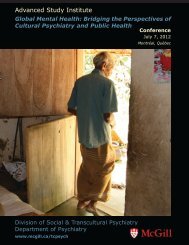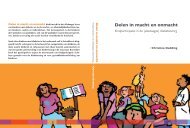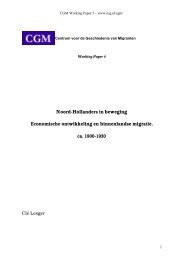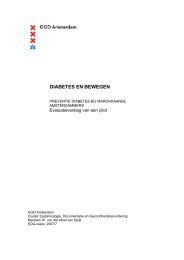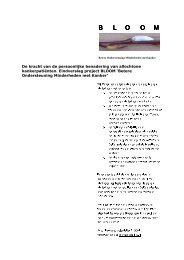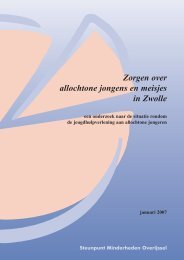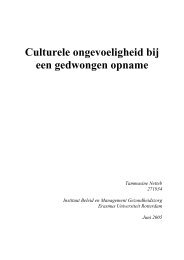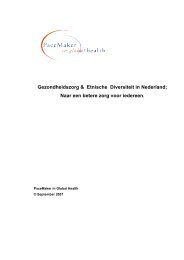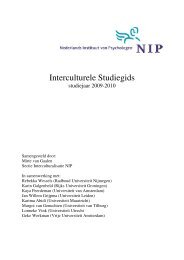Download
Download
Download
You also want an ePaper? Increase the reach of your titles
YUMPU automatically turns print PDFs into web optimized ePapers that Google loves.
In the analysis of the readmission indicator patients who never had an admission of more<br />
than 24 hours were excluded. In the analysis of excess LOS only admissions of more<br />
than 24 hours were included.<br />
As effect modification between age and migrant groups was present we performed all<br />
analyses in two strata, notably patients younger than 45 years and patients of 45 years<br />
and older.<br />
To assess differences in the incidence of readmission within 30 days after a prior<br />
admission, we used stepwise multilevel logistic regression analysis. In the first model<br />
only migrant group and demographics (i.e. age and sex) were taken into account. In the<br />
second model we adjusted for potential confounding by patient mix by adding diagnosis,<br />
comorbidity and principal intervention. In the third model we examined the contribution<br />
of socio-economic indicators to the observed ethnic disparities. The associations between<br />
these factors and the incidence of readmissions within 30 days were assessed by odds<br />
ratios with 95% confidence intervals.<br />
Analogously, a stepwise multivariable logistic regression analysis was applied to assess<br />
disparities in excess LOS between migrant groups, while adjusting for confounding by<br />
patient-mix and finally for socio-economic indicators.<br />
The data in this study were hierarchical: admissions (level 1) are nested within hospitals<br />
(level 2). In a sensitivity analysis we assessed differences in the incidence of readmission<br />
within 30 days after a prior admission and excess LOS using stepwise multivariable<br />
multilevel logistic regression analysis, in which variation in readmission rate was<br />
apportioned to the admission, and hospital level (32,33). Based on the total variance,<br />
intra class correlations (ICCs) were calculated, which give an indication of the extent of<br />
the variance. For example, a high ICC at the hospital level, means that there is more<br />
homogeneity (low variation) within hospitals (patient are treated alike in a hospital), but<br />
high variation between hospitals.<br />
Results<br />
In total 1177,304 admissions from 433,501 patients in 139 hospitals locations were<br />
included in our sample. About 95 % were native Dutch and 5% were from non-OECD<br />
migrant groups. Most migrants were from the first generation, varying from 49% in<br />
Moroccan to 79% in Surinamese patients. Patients from migrant groups were younger<br />
and suffered less often from diseases of the heart, diseases of the arteries and<br />
neoplasms than their Dutch counterparts (Table 1).<br />
After 73,938 (6.3%) clinical admissions a clinical readmission occurred within 30 days<br />
after prior admission. Mean excess LOS of at least 3 days was present in 143,302<br />
(17.5%) admissions.<br />
The risk of readmission within 30 days after the initial admission is presented in table 2a<br />
and 2b for patients younger and older than 45 years of age respectively. In patient<br />
younger than 45 years, without adjustment for patient mix and socio-economic factors,<br />
the risk for readmission within 30 days is higher among Surinamese and Antillean<br />
patients and lower in Turkish patients compared to Dutch patients. After adjustment for<br />
patient-mix the odds ratios became closer to zero but the differences for all three<br />
migrant groups stayed statistically significant. After further adjustment for socioeconomic<br />
factors the differences between migrant groups and Dutch patients slightly decreased.<br />
In patients older than 45 years the risk of readmission within 30 days was higher in<br />
Turkish, Surinamese and Antillean patients than in Dutch patients (model 1). After<br />
adjustment for patient-mix the odds ratios remained stable but became borderline<br />
significant for Surinamese patients. After further adjustment for socioeconomic factors<br />
the differences between Turkish and Surinamese patients compared to Dutch patients<br />
decreased. However, Antillean patients still had a 14% readmission rate within 30 days<br />
than Dutch patients, which were not accounted for by socio-economic status.<br />
38



